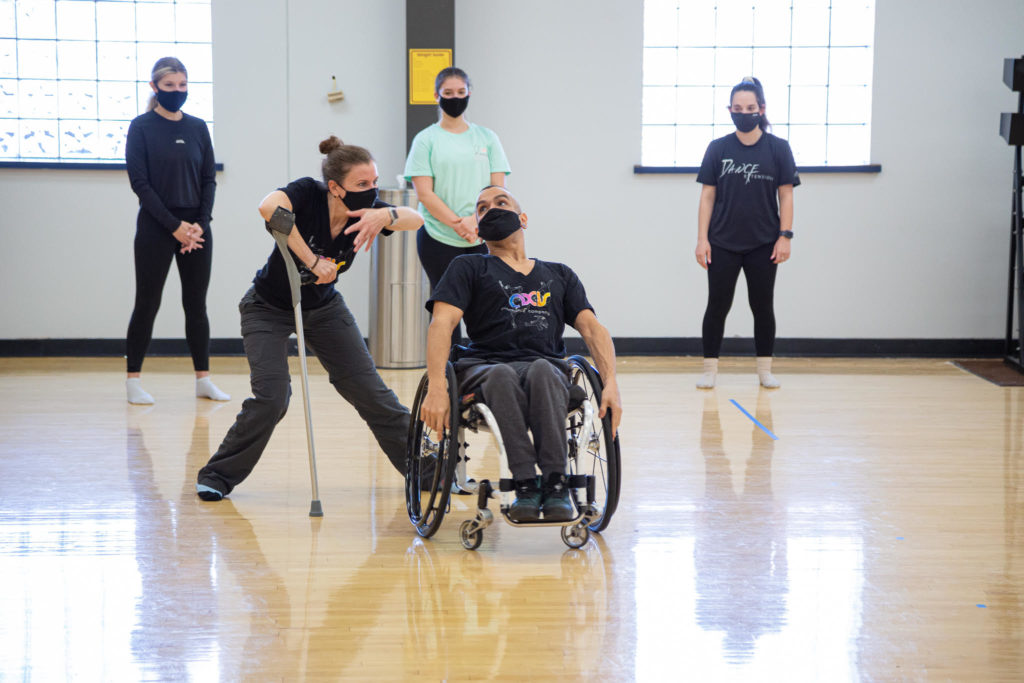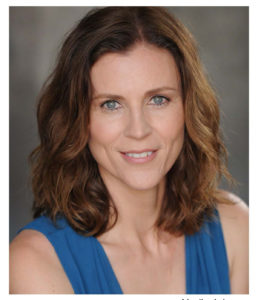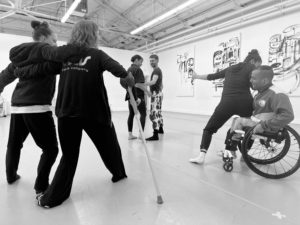
Este artículo fue escrito en inglés y español. Para la versión en español, por favor haga clic aquí.
Natalia Velarde: All right, let’s dive right into it. Tell me a little bit about yourself, what’s your background?
Nadia Adame: I come from Spain. As a child I studied classical ballet and flamenco at the Royal Conservatory of Dance and Drama in Madrid. At age 14, I had a car accident which left me with a spinal cord injury. The doctor said, “You can’t do this anymore. You can’t dance anymore. You have to find another career.” But I thought, “This is what I love doing, why do I need to find something else?”

I decided to choreograph my own show. Yes! A full show at 18 years old. Most of the performers were non-disabled dancers, people I knew from the conservatory. That’s when I started choreographing and producing my own work. We toured all over Spain. But Spain is one of those places where certain things need to move forward, and it was much more that way when I was younger. As a disabled young person there was nowhere for me to go to continue studying dance. I felt like I couldn’t grow, there was no role model for someone like me.
NV: Is that when you came to the US?
NA: Yes, I came to the US to study and improve my English. However, my main goal was to get a degree in dance, but the dance department at University of Colorado did not accept me because of my disability. I decided to apply for the theater department and they took me in.
It was a very good thing for me, I got to immerse myself in the world of theater for 4 years. It gave me the opportunity to learn so much about acting, performing, and a lot of the technical aspects. But it also felt like a missed opportunity because I wasn’t dancing full time. Some professors allowed me into their course so I was able to do some dancing.
After graduating, I reached out to about twenty dance companies because that’s what I really wanted to do. Out of all those companies, only one replied, AXIS Dance Company. Judith Smith, AXIS artistic director at the time, wrote back asking if I could come to Oakland and audition for them.
NV: Ha!
NA: And that was it. That’s how I started dancing for AXIS. It was amazing to me to see people in wheelchairs performing on stage. People like me! I had the opportunity to work with prominent choreographers such as Stephen Petronio, Bill T. Jones, and Sonya Delwaide. My entire world just opened up. It was possible. The dream I had been dreaming became real. It was a great experience.
After that I went to Spain because of family things. My grandfather was very sick and I wanted to spend his last months with him. So my partner, who is a theater director, and I went back and we started a company there. We wanted to introduce this idea of integration; fully-abled performers as well as ones with disabilities together, on stage and engaged in artistic work. We did both theater and dance. We had the company for 10 years, but working in Spain was hard.
NV: What were some of the challenges you encountered running an integrated dance company in Spain?
NA: Finding funding was hard. We tried applying for government grants because the role of foundations is very different over there. Generally speaking, money comes from the government, which is great but some issues come along with that.

NV: What do you mean?
NA: Well, because of my disability I was told to apply for Social Services and not to seek funds allocated for artistic endeavors. And I thought, “No, I don’t do social services. You can’t call me a therapist, that’s not what I do. I didn’t go to school for therapy. I don’t have their knowledge nor their training. I am an artist.” We always found a lot of walls and at that point in time we were not able to get past them. But I think now things are changing, at least that’s what I hear. That’s my story!
NV: As a dance/art maker, what is your intention? What do you hope your work conveys?
NA: A story. It might be my background in theater but I love telling stories, especially through movement. Sometimes these stories are abstract or not necessarily linear, but that’s what I want to convey to the audience. Also, I always talk to the dancers about bringing their stories to the rehearsals. I don’t have to know their personal stories, but our personal experiences can stir feelings that I find are an essential part of the creative process.
NV: Being vulnerable and open.
NA: Yes, I want them to put all of that into the movement I’ve created. And then adapt it and translate it into their bodies, manipulating my movement through their personal experiences. I always ask my dancers to journal so they have a record of what they went through as we develop new work. My goal is to work together.
NV: Collaboration.
NA: I love collaboration. I love talking to different people and taking them on a journey and for them to do the same for me. Going down this road together and discovering new things that maybe need to surface. I love the creative process.
NV: Right. Sometimes it’s even more rewarding than the end product. As a dancer, that’s when I got to learn the most about my art.
NA: I agree, and sometimes it’s frustrating, too. What you’re trying to get out doesn’t come out the way you want or the way you imagine. There can be some frustration but it’s beautiful.
NV: Do you have a particular process or methodology to create?
NA: A lot of people ask me that but I want to surprise myself every single day. I try not to be an artist with a formula who can’t deviate from it and who does the same thing all the time. I’ve seen a choreographer’s first piece and thought, “Wow that was amazing.” Then I’ll go see their next show and it’s very similar to the previous one. Then I’ll go to a third show where everything’s the same: the costume, the type of movement, the lighting, etc. It works for some people and that’s great for them. I admire that. However, I try to discover new things every time because I work with different people, I have new ideas, I’ve hired different dancers, and I want to challenge myself to create different types of movement as well.
NV: What do you look for in a dancer?
NA: Oh, great question. Very hard question. I look for dancers that are willing to throw themselves into the unknown. I look for passion and, you know, technique is always nice to have but it’s not the only thing. I would go for someone with great presence even if they might not have the best technique. Someone who can captivate me and the audience; when they are on stage you can’t help but to look at them. Yes, those are the three things I mostly look for in a dancer.
NV: What are some of the misconceptions people have about integrating dance and disability?
NA: Sometimes, people think it’s going to look like a dance therapy session or think the choreography will be very simplistic. One dancer does this move to the right and then the other dancer does the same thing to the left. Another misconception is that work like mine needs to be inspirational. And inspirational is one of those words that make me think, “Am I inspiring you because I’m doing an amazing job or because I use a cane? If it’s because I have a cane then I don’t want to inspire you.” I want my work to be fulfilling artistically; to stand on its own; to make a statement and make the audience think. Also, the audience is not obligated to like my work just because I’m featuring performers with different abilities.
NV: So you feel like you’re still breaking boundaries?
NA: Yes, I do. Tell me, how many disabled choreographers are choreographing for mainstream companies? How many disabled dancers or actors are actually able to find meaningful work? How many dance companies are led by a disabled director? Around the world, barely any. And as we break boundaries, let’s remember it’s a team effort, it’s all of us. We all want to be recognized for what we do.
But the problem starts earlier. When a young disabled person seeks training in the performing arts, it’s extremely limited. I have spoken with many university dance programs who have received applications from disabled candidates who got rejected because they don’t have the tools to train dancers with different abilities. So, AXIS has developed a program to help dance instructors be more inclusive.

NV: That’s great! Can you tell me more about this program?
NA: We have a teacher training program, which is always part of our summer intensive. We’ve gone to a number of universities and introduced our program. When we talk to professors we ask questions like, “What kind of language do you use? Is it inclusive language?” Somebody like me might not be able to take a ballet class and that’s why I couldn’t get my degree in dance. However, at that point I had seven years of classical ballet training at a conservatory level. Nobody took that into account.
How can you adapt a ballet class for somebody who comes in in a wheelchair? How can one teach and make people with a disability feel like they belong there? In the program, we talk a lot about language adaptation and translation of movement. If I cannot do a rond de jambe with my leg, can I do it with my arms? Can I do it with my head or my torso? We talk about recognizing the purpose of an exercise and translating it into another body part.
I want to bring this program to many other universities and then start reaching below, with high schools perhaps. So if a teacher has somebody with a disability in their classroom, whatever that is, they now know they can adapt instead of exclude.
NV: So after living all over the world, performing for Candoco Dance Company in the UK, founding your own company and working in numerous independent projects, why come back to AXIS?
NA: Being asked back felt like I came full circle. First of all, it was an honor when I got asked to do a presentation for the board and then went through the interview process. This is where I started, where I found the support I needed and where I found people like me. It’s where I feel I can change the world of dance and disability and maybe I can change the field of dance. It feels like home.
NV: Where do you hope to take AXIS during your tenure as artistic director?
NA: One of the biggest goals I had when I joined as artistic director was to raise the salary of my dancers. I remember as a dancer, it was always a struggle and pay is usually low. As a dancer you come into the studio, you have to be creative, you have to give your body, your brain and your soul to the work. And more often than not dancers have to find a second job or they have to teach to afford these expensive Bay Area prices. So, within the first month of 2022, I was able to increase the salary of the dancers by 30%, thanks to the Mellon Foundation. It was huge for us.
A big ambition of mine is to do a lot more international work. We have a huge project in Germany in September and I’m trying to put together a tour of Spain and Italy. I am hoping to solidify all of this in January.
And finally, I want to continue listening and giving back. Both previous artistic directors, Judith Smith and Mark Brew, had such a connection with our community. I want to continue and expand that legacy. Back when I was performing with AXIS, we taught many community classes for children. That was a huge thing for me. Provide young disabled people with the training they wanted and needed. That’s where everything starts; finding disabled dancers is a struggle because of the lack of opportunities to train.
Nadia Adame is a Spanish multidisciplinary award-winning disabled artist. She studied Ballet & Flamenco at the Royal Dance Conservatory of Madrid and has a BA in Theatre from the University of Colorado. She was a company member with AXIS (2001-2003) and Candoco Dance Company (2007-2008). In 2004, she co-founded and was the Co-Artistic Director of Compañía Y in Spain, a multimedia and performance collective. Nadia’s credits include dance, theater, commercial, and independent film projects in the UK, Spain, US, and Canada. In 2022 she became the Artistic Director of AXIS Dance Company.
This article appeared in the Winter 2023 issue of In Dance.

